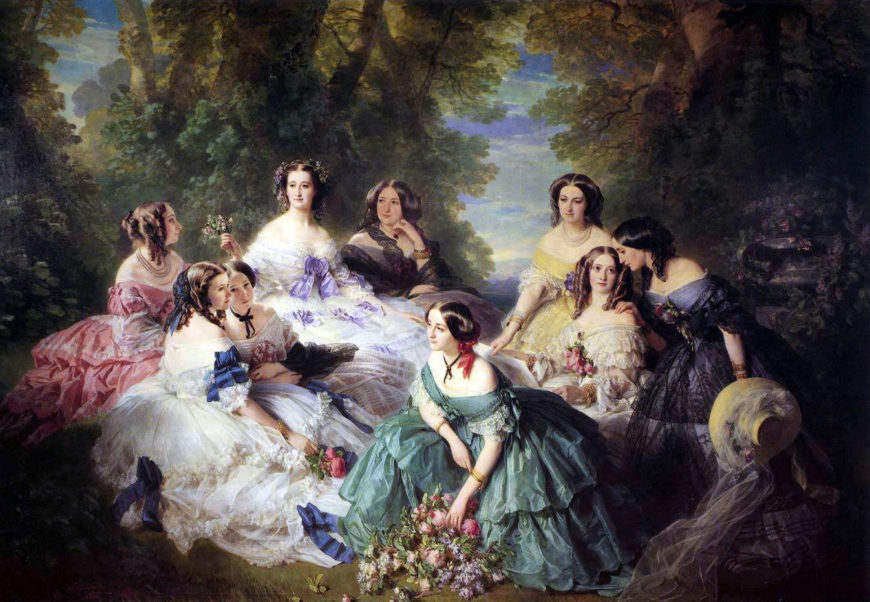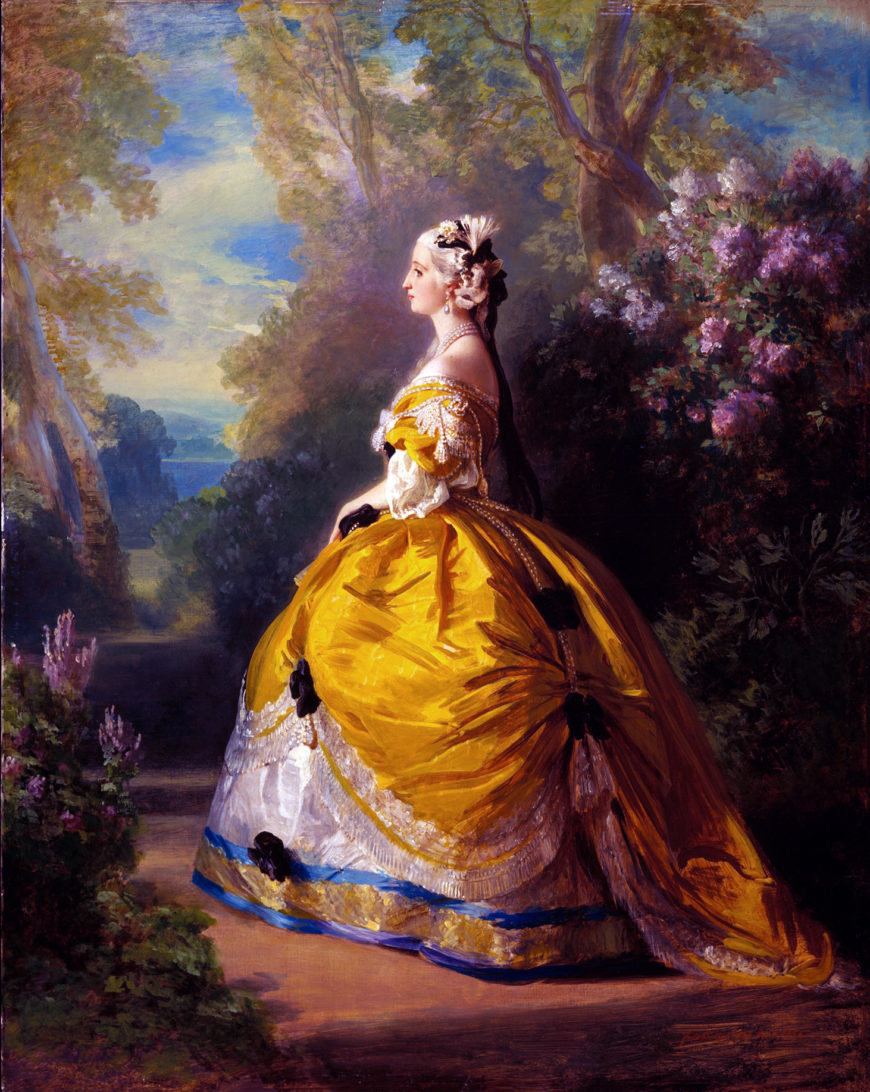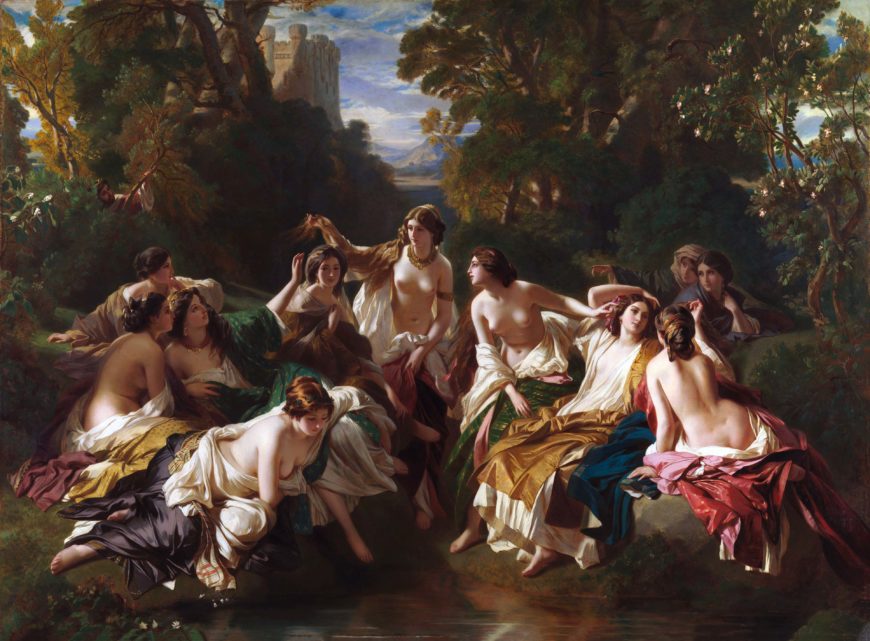
Franz Xaver Winterhalter, The Empress Eugénie Surrounded by her Ladies-in-Waiting, 1855, oil on canvas, 300 x 420 cm (Musées Nationaux du Palais de Compiègne, France)
In a larger-than-life oil painting, a group of beautiful women are arranged in decorative groups within an idyllic forested landscape adorned with roses, lilacs, and other flowers. Titled The Empress Eugénie Surrounded by her Ladies-in-Waiting by artist Franz Xaver Winterhalter, the 1855 portrait depicts the French Empress Eugenie, wife of Napoléon III surrounded by her imperial attendants. As a group, they create a mirage of beauty that seems as ethereal as cotton candy.

André Adolphe Eugène Disdéri, Exposition Universelle des Beaux-Arts, Paris 1855, Salon carré, France, photograph, 37 x 53 cm (Bibliothèque nationale de France)
The painting was first exhibited in 1855 at the Exposition Universelle (Universal Exposition) in Paris, an important international event that was attended by Queen Victoria and Prince Albert as well as more than five million visitors during its run from May to November. This monumental painting was displayed in a prominent position in one of the main exhibition rooms and this placement is notable, especially in light of the fact that Louis-Napoléon’s reign as Emperor was relatively new and had followed a bloody coup that he had initiated in December 1851. What can this deceptively pretty painting reveal about the intersection of fashion and politics during the Second Empire?
Winterhalter and portrait commissions
When an artist undertakes a portrait commission, they must ensure that their client is satisfied with the result if they wish to be paid for their work. Prior to his receiving this commission from Eugénie, the German-born Franz Xaver Winterhalter was a popular portrait painter in European royal and aristocratic circles. Not only was he skillful in capturing the rich textures and subtle details of his sitter’s fashionable clothing, but his portraits were especially flattering to the sitters.

Franz Xaver Winterhalter, The Empress Eugénie (Eugénie de Montijo, Condesa de Teba), 1854, oil on canvas, 92.7 x 73.7 cm (The Metropolitan Museum of Art)
Eugenia de Guzmán, countess of Teba, married Charles-Louis Napoléon Bonaparte III in 1853, and Winterhalter was one of several artists commissioned to create portraits of the new Empress. In the 1850s, photography had not yet become a means of disseminating a sitter’s likeness, and painted portraiture had long been an instrument of politics. In 1854, Winterhalter created a small-scale portrait in which Eugénie is fashioned in tribute to French Queen Marie Antoinette. In this work, Eugénie’s auburn hair is powdered, her olive skin is lightened to a translucent white that resembles porcelain, and her dress references a style once favored by the doomed eighteenth-century French Queen. In this way, the Spanish-born Empress was recast as an iconic French beauty.
As the foreign-born wife of Napoleon III, Eugenie needed to assert her allegiance to the French people. In commissioning this small-scale work by Winterhalter in the year that followed her marriage and adopting a style of dress associated with Marie Antoinette, Eugenie was able to articulate her French identity in service of the newly restored monarchy. The Empress must have been pleased with the work since it hung in a prominent position in her salon de dames of her principal residence for many years. In the years that followed, Winterhalter painted several other portraits of Eugenie, but the best-known, is the large-scale work of Eugenie with her ladies in waiting.

Franz Xaver Winterhalter, The Empress Eugénie Surrounded by her Ladies-in-Waiting, 1855, oil on canvas, 300 x 420 cm (Musées Nationaux du Palais de Compiègne, France)
In Winterhalter’s 1855 group portrait of Eugenie and her entourage, the ladies are seated in decorative groupings. Within this larger-than-life sized work, there is a circular rhythm created by the placement of the figures and the use of diagonal lines in the positioning of their arms. This helps the eye move through the painting. Their porcelain-like complexions are set off against their dark hair and the dark forest background. Each of the women depicted can be identified by name and their placement within the composition reflects the hierarchy of their position. For example, Eugenie hands the symbolic bouquet of violets to the Princess of Essling, her most important companion, and the woman who served as the grande maîtresse.

Franz Xaver Winterhalter, Florinda, 1853, oil on canvas,178.4 x 245.7 cm (The Metropolitan Museum of Art)

Franz Xaver Winterhalter, preparatory sketch of The Empress Eugénie Surrounded by her Ladies-in-Waiting, 1855, oil, 35.5 x 40 cm (Donaueschingen: Fürstlich Fürstenbergische Sammlungen)
The composition for the group portrait of the empress and her attendants borrows from another work by Winterhalter exhibited recently at the Salon in 1853 with the title Florinda. It depicts a scene from the legend of Roderick. In this tale, the last king of the Spanish Visigoths comes across Florinda who is bathing in a garden. In Winterhalter’s depiction, she is seated just left of center and there is strong dynamic movement as the figures on either side form diagonals that lead to the figures in the center. The artist also uses contrast of light and dark to great effect in bringing attention to the women’s supple bodies, porcelain skin tones, and gleaming hair. They are personifications of idealized beauty.
A preparatory sketch of Eugénie with her ladies by Winterhalter indicates that the artist initially considered a slightly larger grouping of attendants.

Franz Xaver Winterhalter, The Empress Eugénie Surrounded by her Ladies-in-Waiting, 1855, oil on canvas, 300 x 420 cm (Musées Nationaux du Palais de Compiègne, France)
For the group portrait of 1855, Winterhalter placed Eugénie seated to the left of center, close to where Florinda had sat, but on a slightly elevated plane. The empress is dressed in a white silk gauze evening gown trimmed with violet-colored silk satin ribbons. Her skin tone is white and her hair decorated with violets—her favorite flower. Her ladies-in-waiting are dressed similarly in elegant floor-length silk evening gowns that range in color from creamy white, pink, yellow, violet, dove gray, to forest green. The deep necklines of their basque bodices showcase graceful necks and bared arms while the expansive crinolined skirts with tiered flounces encircle their legs in pools of fabric. Each lady is portrayed in a most flattering light—with flawless skin, lustrous hair, an elegant figure, and a refined pose.

Franz Xaver Winterhalter, The Empress Eugénie Surrounded by her Ladies-in-Waiting (detail), 1855, oil on canvas, 300 x 420 cm (Musées Nationaux du Palais de Compiègne, France)
Why does fashion matter in this painting?
There is a heightened sense of femininity in this work. The expansive lengths of colorful silks, ornate trims of lace and silk ribbons that make up the lady’s fashionable dresses are visible signifiers of wealth and class. During the Second Empire of Napoléon’s reign, elaborate rules around appearance governed what could be worn and when, such that ladies like those depicted in this work typically changed their clothes at least seven or eight times in a day. Both day and evening dresses were worn over layers of underclothes, including corsets and crinolines (a stiff petticoat that gave shape to a woman’s skirt) that created a bell-shaped silhouette either through layers of petticoats or through a metal armature. Crinolines gave the illusion of a slender waist by widening the hips, and as such they were a notable signifier of femininity. Although they also reduced a woman’s mobility and distanced her physically from others, crinolines were extremely popular. Eugenie was an early adopter of this fashion and as a fashion leader, she came to be nicknamed the “Countess of Fashion.” In Winterhalter’s group portrait, Eugénie and the noble ladies of the French court are dressed in the height of French fashion as models of femininity and beauty.
This painting is more than a pretty picture of ladies in a landscape. Instead, this monumental work by Winterhalter, considered his best-known work and seen by millions, might more accurately be understood as a work of propaganda by the politically astute Napoléon III. Eugenie holds a bouquet of violets in her right hand—a symbol that would be recognized as a symbol of loyalty by Bonapartist supporters. In positioning his wife as the model of femininity and the fashionable centerpiece within a circle of beautiful ladies of the French imperial court, the Spanish-born Eugénie was recast as the fashionable, elegant and beautiful ornament of the Second Empire. In its placement in a prominent position at the 1855 Salon, Napoleon harnessed the power of art to convey ideas of power and prestige.
As this example shows, using fashion as a lens of analysis can reveal a nuanced understanding of a work. Beneath Winterhalter’s seemingly superficial depiction of a group of beautiful ladies in a pastoral setting, the nuances of political power, gender, and ethnicity are revealed.
Additional resources:
Laure Chabanne, “Eugénie, impératrice de la mode?” [Eugénie, Empress of Fashion?] in Sous L’Empire des Crinolines [Under the Empire of the Crinolines]. (Paris: Musée Galliera, 2009.)
Alison McQueen, Empress Eugénie and the Arts: Politics and Visual Culture in the Nineteenth Century (Ashgate Publishing, 2011).
Ingrid E. Mida, Reading Fashion in Art (Bloomsbury Visual Arts, 2020).
Phillippe Perrot, Fashioning the Bourgeoisie: A History of Clothing in the Nineteenth Century , translated by Richard Bienvenu (Princeton University Press, 1994).
Portrait of The Empress Eugénie by Winterhalter at The Metropolitan Museum of Art

